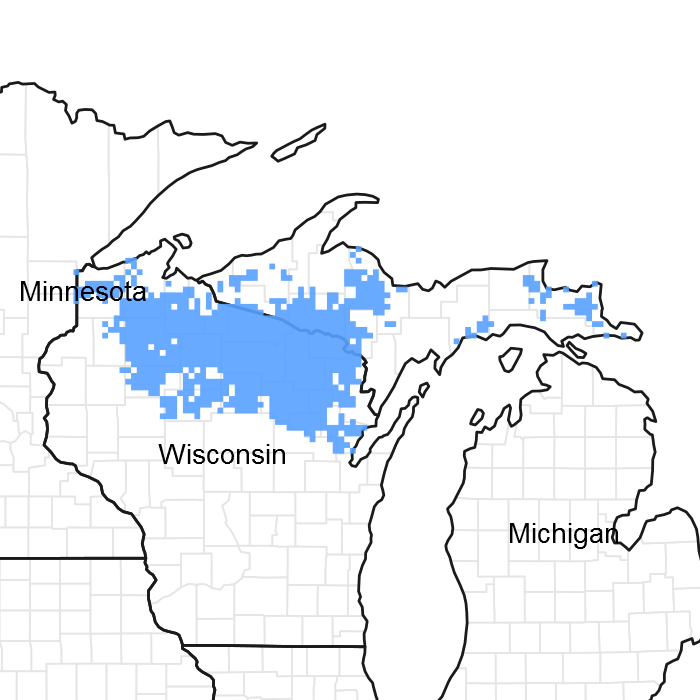
Natural Resources
Conservation Service
Ecological site F094DY013WI
Loamy-Mantled Terraces And Plains
Accessed: 12/17/2025
General information
Provisional. A provisional ecological site description has undergone quality control and quality assurance review. It contains a working state and transition model and enough information to identify the ecological site.

Figure 1. Mapped extent
Areas shown in blue indicate the maximum mapped extent of this ecological site. Other ecological sites likely occur within the highlighted areas. It is also possible for this ecological site to occur outside of highlighted areas if detailed soil survey has not been completed or recently updated.
MLRA notes
Major Land Resource Area (MLRA): 094D–Northern Highland Sandy Pitted Outwash
The Loamy-Mantled Terraces and Plains ecological site occupies about 15,000 acres in MLRA 94D
Classification relationships
The Loamy-Mantled Terraces and Plains ecological site correlates to a hybrid of ATM and ATD habitat types developed by Kotar and Burger (2002); these habitat types are named after Acer saccharum (sugar maple)- Tsuga canadensis (eastern hemlock)/ Maianthemum canadense (Canada mayflower) and Acer saccharum (sugar maple)- Tsuga canadensis (eastern hemlock)/ Dryopteris spinulosa (spinulose shield fern), respectively. These species have very high constancy value relative to this site, i.e. they are present on a higher percentage of these sites than other species. This ecological site has a mesic moisture regime and is medium in nutrients.
Ecological site concept
ATTENTION: This ecological site meets the NESH 2014 requirements for PROVISIONAL. A provisional ecological site is established after broad ecological site concepts are identified and an initial state-and-transition model is drafted. Following quality control and quality assurance reviews of the ecological site concepts, an identification number and name for the provisional ecological site are entered into ESIS. A provisional ecological site may include literature reviews, land use history information, some soils data, legacy data, ocular estimates for canopy and/or species composition by weight, and even some line-point intercept information. A provisional ecological site does not meet the NESH 2014 standards for an Approved ESD, but does provide the conceptual framework of soil-site correlation for the development of the ESD. For more information about this ecological site, please contact your local NRCS office.
The Loamy-Mantled Terraces and Plains ecological site is the richest non-wet site in the region. The loamy mantle is 10 to 40 inches thick consisting primarily of sandy loam, loam or silt loam. The loamy mantle increases both water-holding capacity and fertility compared to the sandy ecological sites. This site occurs on nearly level slopes typically found between steeper areas and low-lying areas. If the site occurs as a narrow band it resembles a terrace, if it occurs as a broad expanse, roughly equal in all directions from a central point, then it is called a plain. The vegetation is mixed hardwood and conifer forest, with sugar maple and eastern hemlock common associates in climax communities. In the undisturbed state, the understory is often low-growing and dominated by shade-tolerant ferns, club mosses and spring ephemerals because the forest canopy is so dense.
Associated sites
| F094DY010WI |
Wet Sandy Depressions Loamy-Mantled Terraces and Plains are typically adjacent to Loamy-Mantled Uplands. |
|---|---|
| F094DY012WI |
Steep Loamy-Mantled Ridges Loamy-Mantled Drainageways frequently occur downslope from Loamy-Mantled Terraces and Plains. |
Table 1. Dominant plant species
| Tree |
(1) Acer saccharum |
|---|---|
| Shrub |
(1) Lonicera canadensis |
| Herbaceous |
(1) Dryopteris spinulosa |
Click on box and path labels to scroll to the respective text.
